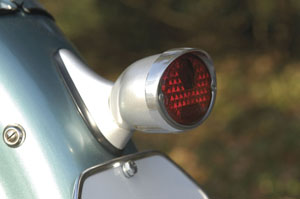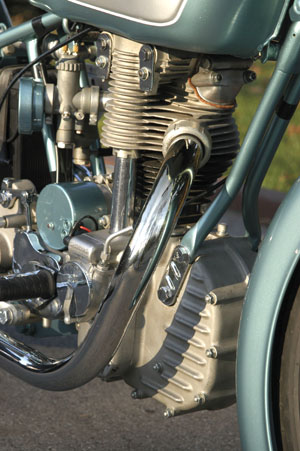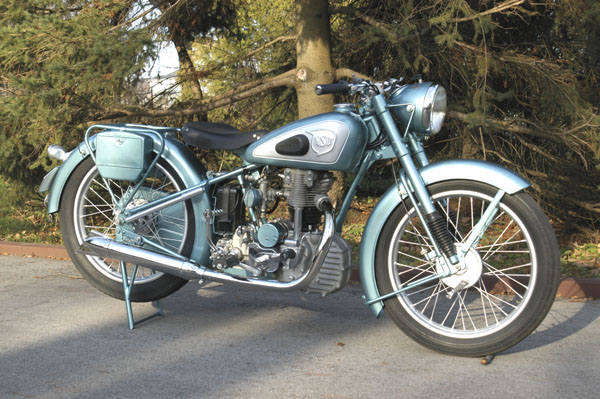
THE COLLECTION - Bikes for Sale - About Bar - Current Projects - Links - Archives - Contact - Main

Origainally published in International Motorcycle, January 2004 Vol.14/Iss.1 | |
NSU - the German JewelBy Steve BondPhotos by Bar & Hedy Hodgson
| |
|
Kurt Boeckmann is undoubtably the premier NSU restorer in Canada - perhaps the world - and before I could interview him I figured I had to learn a bit about the marque. When it comes to German motorcycles, I admit that I really don't know my achtung from a hole in the ground. I once figured that since I'd ridden a few BMWs, I'd pretty well covered the lot. Upon further research, I discovered that there were a significant number of German manufacturers, one of the most interesting and successful being NSU.
| |

| |
| NSU originally started out making knitting machines and, in fact, the initials stand for (take breath here) Neckarsulm Strickmaschinen Union: Neckarsulm being the name of the town in southern Germany where the manufacturing plant was located, 'strickmaschinen' meaning 'knitting machines' and 'union' meaning, um union. | |
|
The company branched out into making bicycles and then around 1901 built its first motorcycle. Development progressed fairly rapidly and flirted with the cutting edge of the era's technology, including producing a liquid-cooled single in 1905, a 350 cc V-twin in 1912 and a 1,000 cc V-twin in 1920 that produced a whopping 15 horsepower.
|

|
|
The motorcycles were actually quite good for the day and increased export sales meant that non-Teutonic types had trouble pronouncing Necksarulm, er Nosesock, that is, Nesslem - the company name - so the tank emblems were rebadged to a simple and pronounceable 'NSU'. Either that or the cost of labour and paint to apply the name cut too deeply into profit margins.
| |

|
In a rare industrial espionage about-face, the German company hired British designer Walter William Moore away from Norton in 1929 and presto - NSU produced a bevel-gear OHC single cylinder 500 that looked eerily similar to a Norton Manx. Disgruntled British enthusiasts soon began grumbling that NSU actually stood for 'Norton Spares Used'.
|
|
Towards the end of the 1930s, NSU was well on its way to becoming one of the largest motorcycle producers in the world. They even dabbled in a supercharged 350 cc twin Grand Prix racer called the 'Kompressor' in 1938 that was blazingly fast and remarkably unreliable. When World War 2 broke out, NSU chipped in with the Kleines Kettenkraftrad or 'small-tracked motorcycle'. It was basically the front end of a motorcycle grafted onto the rear end of a half track. The handlebars not only steered the front wheel but operated differentials on the tracks, thereby assisting in turning the vehicle. NSU made thousands of these 1,500 cc four-cylinder Opel-powered machines, most of them being assigned to Wehrmacht Panzer units. | |
|
After the war, Germany was rebuilt and in 1950, NSU was back in business with a towershaft DOHC four-cylinder 500 for the Grand Prix circus. But instead of racing the 500, the company 'sliced' a 125 single and 250 cc twins from the design and campaigned them instead. These bikes, called the Rennfox and Rennmax respectively, were quite successful, winning a string of world championships until NSU withdrew from racing in 1954.
Offshoots of the GP bikes were a couple of pretty good street motorcycles, not surprisingly called the Fox and Max. The 250 Max was quite revolutionary for its time. The SOHC engine sported a dry clutch and an ingenious cam drive system that was silent, efficient, and so compact that the top end of the engine is easily be mistaken for a two-stroke.
|

|
|
A pressed steel frame was ideally suited to mass production, while leading link forks were inexpensive to produce while providing a good ride and consistent steering. The spring for the rear suspension was hidden in the frame, the drive chain was enclosed and the bike came standard with what appeared to be tiny rear luggage compartments. In fact, one 'saddlebag' housed the battery while the other was for the extensive tool kit.
NSUs were extremely popular in Europe and reasonably so in Canada. In the 1950s, there wasn't a lot of choice - either you were a Harley rider or a Brit-bike rider - and the two groups didn't mix. Here in the Frozen North, strangely enough, NSUs were sold through Harley-Davidson dealers as an alternative to British bikes.
| |

|
Back to Mr. Boeckmann the restorer, of which two prime examples of his work appear in these pages. He¹s a quiet gentleman living in the Peterborough area, who has developed a passion for the NSU marque.
"I rode motorcycles when I was younger but didn¹t touch a motorcycle for 30 years", says Boeckmann. He started tinkering with cars but "they took up too much room so I went back to bikes". His first motorcycle restoration was a Zundapp. He came across a couple of NSUs and the rest is history.
Boeckmann likes NSUs because "they're over-engineered and many parts are the same between models. My favourite NSU would have to be the 250 scrambler model. There were only 200 made all of them strictly for California desert racing". Kurt's restored scrambler won Best in Show at last year's Ride to Remember Concours judging. The two featured Boeckmann-restored NSUs now are part of The Bar Hodgson Collection. The marque is still very popular in Europe and many extremely high-quality NSU reproduction parts are still being manufactured. A good source of information is the Deutsches Motorrad Register (DMR) available in European shops, but they'll ship here as well.
|
|
In the late 1950s, NSU began dabbling in producing a small car powered by a four-cylinder engine based on the Max design eccentric connecting rod cam drive system and all. It was so successful that in 1963, NSU sold the motorcycle operation to the Yugoslavians, who moved everything to Sarajevo. NSU then obtained the German license to the Wankel rotary engine and developed a very successful version of it, leading to their being absorbed by VW-Porsche-Audi. The Wankel was subsequently licensed to a number of firms both motorcycling and automotive. Hercules and Suzuki built production models (Yamaha did a show bike but no more), but today only Mazda uses the design in their RX sport cars. Today, the former NSU motorcycle factory in Neckarsulm is a museum housing one of the finest collections of bikes known to exist.
| |

| |
The Collection - Bikes for Sale - About Bar - Current Projects - Links - Archives - Contact - Main